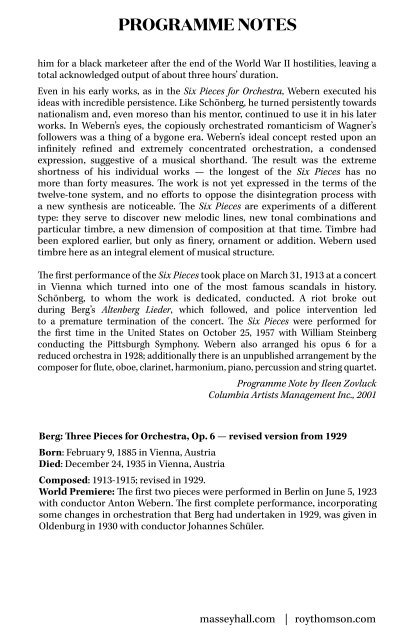Programme
BerlinerPhilharmoniker-Programme
BerlinerPhilharmoniker-Programme
You also want an ePaper? Increase the reach of your titles
YUMPU automatically turns print PDFs into web optimized ePapers that Google loves.
PROGRAMME NOTES<br />
him for a black marketeer after the end of the World War II hostilities, leaving a<br />
total acknowledged output of about three hours’ duration.<br />
Even in his early works, as in the Six Pieces for Orchestra, Webern executed his<br />
ideas with incredible persistence. Like Schönberg, he turned persistently towards<br />
nationalism and, even moreso than his mentor, continued to use it in his later<br />
works. In Webern’s eyes, the copiously orchestrated romanticism of Wagner’s<br />
followers was a thing of a bygone era. Webern’s ideal concept rested upon an<br />
infinitely refined and extremely concentrated orchestration, a condensed<br />
expression, suggestive of a musical shorthand. The result was the extreme<br />
shortness of his individual works — the longest of the Six Pieces has no<br />
more than forty measures. The work is not yet expressed in the terms of the<br />
twelve-tone system, and no efforts to oppose the disintegration process with<br />
a new synthesis are noticeable. The Six Pieces are experiments of a different<br />
type: they serve to discover new melodic lines, new tonal combinations and<br />
particular timbre, a new dimension of composition at that time. Timbre had<br />
been explored earlier, but only as finery, ornament or addition. Webern used<br />
timbre here as an integral element of musical structure.<br />
The first performance of the Six Pieces took place on March 31, 1913 at a concert<br />
in Vienna which turned into one of the most famous scandals in history.<br />
Schönberg, to whom the work is dedicated, conducted. A riot broke out<br />
during Berg’s Altenberg Lieder, which followed, and police intervention led<br />
to a premature termination of the concert. The Six Pieces were performed for<br />
the first time in the United States on October 25, 1957 with William Steinberg<br />
conducting the Pittsburgh Symphony. Webern also arranged his opus 6 for a<br />
reduced orchestra in 1928; additionally there is an unpublished arrangement by the<br />
composer for flute, oboe, clarinet, harmonium, piano, percussion and string quartet.<br />
<strong>Programme</strong> Note by Ileen Zovluck<br />
Columbia Artists Management Inc., 2001<br />
Berg: Three Pieces for Orchestra, Op. 6 — revised version from 1929<br />
Born: February 9, 1885 in Vienna, Austria<br />
Died: December 24, 1935 in Vienna, Austria<br />
Composed: 1913-1915; revised in 1929.<br />
World Premiere: The first two pieces were performed in Berlin on June 5, 1923<br />
with conductor Anton Webern. The first complete performance, incorporating<br />
some changes in orchestration that Berg had undertaken in 1929, was given in<br />
Oldenburg in 1930 with conductor Johannes Schüler.<br />
4 Flutes (Piccolos)<br />
4 Oboes (4 th also<br />
English Horn)<br />
4 Clarinets (3 rd also<br />
Clarinet in E flat)<br />
Bass Clarinet<br />
3 Bassoons<br />
Contrabassoon<br />
PROGRAMME NOTES<br />
Instruments<br />
6 Horns<br />
4 Trumpets<br />
4 Trombones<br />
Tuba<br />
Timpani<br />
Drums<br />
Celesta<br />
2 Harps<br />
Strings<br />
Alban Berg first heard of Arnold Schönberg in 1904 when Schönberg placed<br />
an ad in a Vienna newspaper seeking students. The relationship that resulted<br />
from this advertisement provided Berg with a mentor and father-figure, and more<br />
importantly, with a composition teacher from whom he learned twelve-tone<br />
techniques. Schönberg is perhaps best known as the first composer who<br />
abandoned conventional tonality for a style he called “pantonality,” but which<br />
others called “atonality.” Along with their colleague Anton Webern, Berg and<br />
Schönberg originated what now is called the Second Viennese School<br />
of serialism, which involves using all the semitones of the scale in the<br />
formation of a “tone-row” which provides the motivic basis of a given piece; in strict<br />
serialism, no tone can be repeated until the other eleven have been sounded.<br />
At the age of fifteen, Berg started composing, although at an earlier age he wanted<br />
to be a poet, and three years later began his studies with Schönberg; at the same<br />
time he also met Webern, who would be a lifelong friend to Berg. These three men<br />
would cause quite a commotion with their music in Vienna and, led by Schönberg,<br />
would implement changes in music that would alter its course for all time. The<br />
audiences’ response to these changes were sometimes less than favorable: In<br />
March 1913, in Vienna, Schönberg conducted a concert which included the<br />
premieres of Berg’s first orchestral works, Nos. 2 and 4 of the Altenberg songs. The<br />
performance, referred to above, resulted in one of the worst riots over music in the<br />
history of the city.<br />
Berg’s early compositions had consisted of songs, piano works and some chamber<br />
music. In 1912, he decided that he wanted to write something on a bigger scale —<br />
a symphony or perhaps an orchestral suite. In 1914 he began to compose the<br />
Orchestrestücke, which he intended to present for Schönberg’s 40th birthday (Sept<br />
13, 1914). Completed in 1915, the work was neither a symphony nor a suite, but<br />
rather a combination of both.<br />
Berg’s Three Pieces for Orchestra, Op. 6, are scored for large orchestra with<br />
generous percussion resources and with strings divided into five sections.<br />
Dedicated to Schönberg, they are essentially post-Romantic, despite their<br />
extreme chromaticism, unusual chord progression and considerable dissonance.<br />
The Präludium is colorful and impressionistic. It grows out of the sound of<br />
unpitched percussion, settling around E-flat, and offers some thematic<br />
masseyhall.com | roythomson.com<br />
masseyhall.com | roythomson.com


